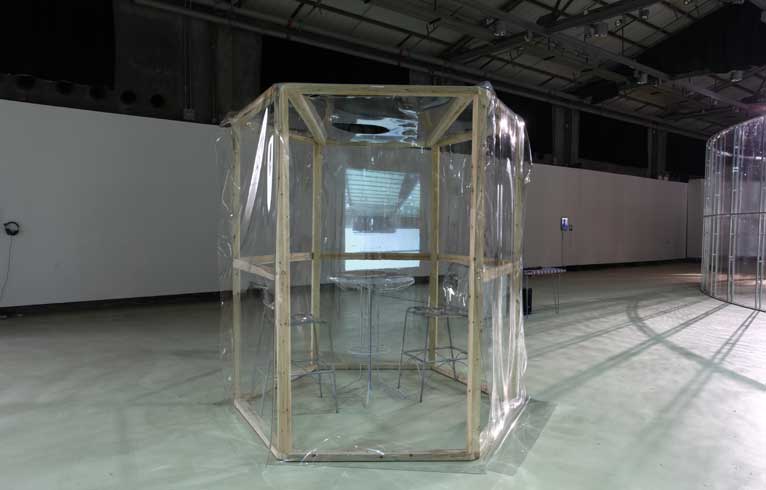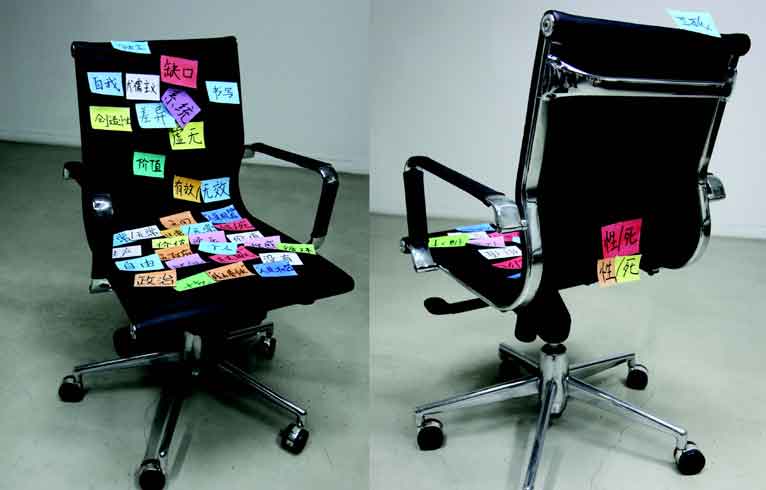POSSIBLE VOCABULARY GAMES
| May 4, 2011 | Post In LEAP 8

Summarizing Xu Tan’s “Keywords” project in a few sentences is an extremely difficult task, and even the artist himself has trouble describing it clearly. In fact, his 2005 solo exhibition “Loose” contained something similar in “100 Daily Words,” which extracted relatively popular words from daily life. Soon afterward, he self-consciously expanded his scope to include not only the category of popularity factors like frequency and political sensitivity as selection criteria. He also began to seek out rarely used but extremely important “implied words.” Thus, “Keywords” took shape. Xu adjusted and expanded his work methods, and certain sociological techniques, such as calculation and statistics, played important roles behind the scenes. The more visible elements of the project mainly comprised interviews and dialogue. He conducted impromptu investigations in the omnipresent linguistic field to collect language samples, including text, sound, and video for later analysis. Ultimately, Xu sifted out a set of keywords from these language samples. Through this lexicon, we can gain some insight into certain phenomena related to social consciousness.
Xu Tan insists that the goal of his work is not to conduct linguistic or sociological research. His projects have a certain scientific bent, but absent from them are the abstract, conceptual, and logical processes and conclusions of scientific research. On the contrary, they maintain a superficial, makeshift feel. The key is that Xu contextualizes these words in extremely concrete linguistic contexts, highlighting how a word is pronounced, intoned, and expressed in a single sentence during a specific conversation. Clearly, Xu’s intention is not the examination of semantic concepts of words in dictionaries, but rather, the observation of language’s applications in daily life. He encourages us to consider non-conceptual yet communicative aspects of speech, including cues that are not directly expressed in words and can only be spontaneously sensed.
Thus, Xu Tan’s work, in sharp contrast to linguistic research, places just as much emphasis on the vocal and visual aspects of speech as it does on semantics. For example, Xu asks his interviewees to assign colors to the keywords. These colors do not constitute a symbolic system in the way that a traffic light does; they merely reflect the individual sentiments of the interviewee, manifesting certain color-associated feelings and preferences. When I look through these keywords, the color tags remind me of the value of their non-conceptual attributes. This tagging method also appeared in recordings played in Xu’s 2007 “Keywords School.” Whenever the speaker reached a keyword, the recording of his or her pronunciation was stressed or elongated. Interestingly, I remember the sound of those distorted inflections to this day, even though I’ve forgotten which words were spoken.

To put it as simply as possible, “Keywords” attempts to pull the audience, the participants, and the artist himself into a “scene of consciousness” in which words are alive. Therefore, Xu Tan approaches this show at OCAT as a “language workshop” that is not designed to convey a specific conclusion to the audience. On the contrary, the show seeks to heighten the “scene of consciousness,” that is, namely, the “linguistic field.” This show can be described as a progress of continuous dialogue between Xu and the various participants, and thus, it can be seen as a paradigm for the entire “Keywords” project.
Virtually everything in the exhibition hall has been arranged to create a certain kind of environment for dialogue. The project data, including videos, text, and manuscripts all line the walls, which contain three areas for talking, two of which are enclosed but transparent. The smallest of these spaces accommodates a private tête-à-tête; the second space is a reference room big enough for group discussions; and the largest space, an open semi-circular shape (Xu Tan calls it the “Echo Wall,” after the circular edifice in Beijing’s Temple of Heaven), is located in the center of the hall. This space allows a greater number of visitors to participate in public dialogue.
Also noteworthy are the materials used in the construction of these spaces. They are all relatively simple and cheap, creating an unspectacular, functional environment. The choice of these materials demonstrates a specific effort to resist the inclination to “landscape” a show in order to strike awe into visitors. Striped plastic fabric has always been Xu Tan’s favorite readymade material, and it has been present throughout the “Keywords” project; in this show, it takes the form of seat covers. To enclose the spaces, he chose a pliant PVC film, safer and cheaper than glass. This soft material presents no sense of rigid separation between spaces. Light steel was used for the frames of the chairs and the PVC enclosing walls. This material was provided by a company that hosted a Keywords School event in Qingdao. The company, Cowin Global, produces products such as shopping carts and luggage carts; Xu laid claim to the company’s irregular building materials and shipped them from Qingdao to Shenzhen. He also refashioned the wooden packing materials used in the shipment into a set of shelves for the smallest dialogue space.
The effect created by the interaction of these details perfectly captures Xu Tan’s thinking, methodology, and unique understanding of artistic activity. In a conversation with the show’s curator, Huang Zhuan, he described art as a river: “In the river, the work exists in a unified form. The water continuously flows downstream and continually flings fragmented ‘crystallizations’ of visual artistic significance upon its banks. These crystallizations don’t look like paintings, sculptures, films or any sort of conclusion, but rather, they provide a sense of the situation of the river.” Thus, the items in the exhibition hall—and even the show itself—they are all “crystallizations,” a set of results both impossible to avoid and unnecessary to reject. But Xu’s true hope is that people will grasp the process of their personal experience and the occurrences that constitute that process. Today, as the ideas of conceptual art seem to become evermore dry and barren, Xu is attempting to use an emphasis on praxis to breathe life into concepts.
In this language workshop, Xu Tan investigates language and consciousness while playing “possible vocabulary games.” As for whether we can use these keywords to approach a certain social consciousness, and the significance of this consciousness—for now, those topics are secondary. Bao Dong


